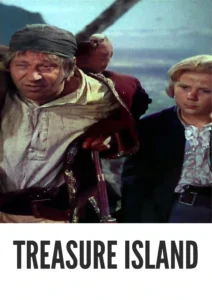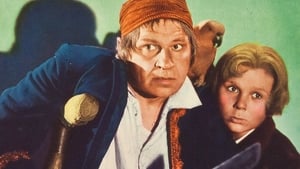Contact: info@alwanfilm.com
Video Sources 0 Views
- Watch trailer
- Treasure Island


Synopsis
Table of Contents
ToggleReview: Treasure Island 1934 Colorized – A Swashbuckling Adventure of Mythic Proportions

Introduction
“Treasure Island” (1934) embarks audiences on a thrilling journey of pirates, treasure hunts, and daring escapades, capturing the imagination with its timeless tale of adventure on the high seas. In this review, we’ll delve into the significance of this classic film, exploring its impact on audiences and its enduring legacy in the realm of adventure cinema.
Check The Full Colorized Movies List
Check Our Colorized Movies Trailer Channel
Understanding Treasure Island 1934 Colorized: Director, Cast, and Genre
Directed by Victor Fleming, “Treasure Island” (1934) showcases his skill in bringing epic tales to life on the silver screen. The film boasts a talented cast, including Wallace Beery as the infamous Long John Silver, whose charismatic performance steals the show. With its blend of action, drama, and intrigue, “Treasure Island” (1934) immerses viewers in a world of swashbuckling adventure and timeless romance.
Exploring the World of Treasure Island 1934 Colorized: Plot and Characters
At its heart, “Treasure Island” (1934) follows the young Jim Hawkins as he embarks on a perilous journey to find buried treasure with a crew of colorful characters, including the enigmatic Long John Silver. As they navigate treacherous waters and face off against rival pirates, Jim discovers the true meaning of courage, friendship, and honor in the face of danger. With its memorable characters and thrilling plot twists, “Treasure Island” (1934) captivates audiences with its epic tale of bravery and betrayal on the high seas.
The Art of Film Colorization
Film colorization serves as a transformative tool that enhances the visual experience of classic movies, breathing new life into timeless stories and captivating audiences with vibrant hues. By digitally adding color to black and white films, colorization allows viewers to immerse themselves in the rich tapestry of cinematic worlds, exploring every nuance and detail with fresh eyes and renewed appreciation.
Early Colored Films: A Brief History
The history of colored films traces its roots back to the early days of cinema, with filmmakers experimenting with various techniques to add color to their creations. From hand-tinted frames to early Technicolor processes, the evolution of colored film has been marked by innovation and ingenuity, paving the way for the development of modern colorization techniques that continue to captivate audiences to this day.
Treasure Island 1934 and Its Early Colored Version
The decision to release “Treasure Island” (1934) in a colorized format was met with both excitement and trepidation. While some welcomed the opportunity to experience the film in vibrant color, others expressed concerns about the potential impact on its visual aesthetic. Nevertheless, the early colored version of “Treasure Island” (1934) offers viewers a fresh perspective on the timeless tale of adventure, enhancing its immersive qualities and captivating audiences with its luminous beauty.
The Debate Over Film Colorization
The debate over film colorization continues to divide audiences and critics alike, with proponents praising its ability to breathe new life into classic movies and introduce them to a new generation of viewers, while detractors argue that it compromises the artistic integrity of the original work and diminishes its historical significance. As the debate rages on, filmmakers and audiences alike are left to ponder the merits and drawbacks of colorization in the ever-evolving landscape of cinema.
Examining Treasure Island 1934 as an Early Colored Film
As with any colorized classic, the impact of colorization on “Treasure Island” (1934) is a matter of personal interpretation. Some may argue that it enhances the film’s visual appeal and immerses viewers in its world, while others may feel that it detracts from the stark beauty of the original black and white version. Regardless of one’s stance on the issue, there’s no denying the enduring power of “Treasure Island” (1934) as a timeless adventure that continues to capture the hearts of audiences around the world.
Influence and Legacy: Treasure Island 1934 Colorized’s Impact on Cinema
“Treasure Island” (1934) has left an indelible mark on the world of cinema, inspiring countless filmmakers and captivating audiences with its timeless tale of adventure and intrigue. From its unforgettable performances to its sweeping cinematography, the film continues to resonate with viewers of all ages, reaffirming its status as a beloved classic of the adventure genre.
Director’s Cinematic Legacy: Beyond Treasure Island 1934 Colorized
Victor Fleming’s influence extends far beyond “Treasure Island” (1934), with a diverse body of work that continues to captivate audiences around the globe. From “Gone with the Wind” to “The Wizard of Oz,” Fleming’s films are celebrated for their epic scope, dynamic characters, and timeless themes, solidifying his legacy as one of the preeminent directors of Hollywood’s Golden Age. Through his groundbreaking work, Fleming has left an indelible imprint on the world of cinema, inspiring generations of filmmakers to follow in his footsteps.
Themes Explored in Treasure Island 1934 Colorized
“Treasure Island” (1934) explores a myriad of themes, from the allure of adventure to the complexities of morality and loyalty. Through its richly drawn characters and sweeping narrative, the film invites viewers to ponder the nature of heroism and the pursuit of treasure, both literal and metaphorical. As audiences immerse themselves in the world of “Treasure Island” (1934), they are reminded of the timeless truths that bind us together as human beings and the enduring power of storytelling to inspire, entertain, and provoke thought.
Reception and Controversy Surrounding Treasure Island 1934 Colorized
Upon its release, “Treasure Island” (1934) received widespread critical acclaim, with many praising its thrilling action sequences, memorable performances, and breathtaking cinematography. However, the decision to release the film in a colorized format sparked debate among purists, reigniting the age-old discussion surrounding film preservation and artistic integrity. Despite the controversy, “Treasure Island” (1934) remains a beloved classic that continues to resonate with audiences of all ages, reaffirming its status as a timeless masterpiece of the adventure genre.
Where to Watch Treasure Island 1934 Colorized Online
For those eager to experience the timeless magic of “Treasure Island” (1934), the film is readily available on popular streaming platforms such as Netflix, Amazon Prime, and Hulu. Whether you choose to watch it in its original black and white format or the early colored version, “Treasure Island” (1934) promises to transport you to a world of adventure and intrigue, where danger lurks around every corner and the promise of treasure beckons from afar.
FAQs About Treasure Island 1934 Colorized
Q: Is “Treasure Island” (1934) based on a true story? A: No, “Treasure Island” (1934) is a fictional tale adapted from the classic novel by Robert Louis Stevenson, whose timeless story of adventure and intrigue has captured the imagination of readers for generations.
Q: Who are the main actors in “Treasure Island” (1934)? A: “Treasure Island” (1934) features an ensemble cast led by Wallace Beery as the notorious Long John Silver, whose charismatic performance anchors the film. Other notable actors include Jackie Cooper as Jim Hawkins and Lionel Barrymore as Billy Bones, each bringing their own unique talents to their respective roles.
Q: What awards did “Treasure Island” (1934) win? A: While “Treasure Island” (1934) did not win any major awards, it received critical acclaim for its thrilling action sequences, memorable performances, and sweeping cinematography, cementing its status as a beloved classic of the adventure genre.
Q: Why was “Treasure Island” (1934) released in a colorized format? A: The decision to release “Treasure Island” (1934) in color was made to introduce the film to a new generation of viewers and enhance its visual appeal for modern audiences. While the choice to colorize the film sparked debate among purists, it ultimately allowed “Treasure Island” (1934) to reach a wider audience and ensure its continued relevance in the annals of cinematic history.
Conclusion
“Treasure Island” (1934) stands as a timeless classic that continues to captivate audiences with its thrilling action, memorable characters, and breathtaking cinematography. Whether viewed in its original black and white format or the early colored version, the film remains a shining example of the power of cinema to inspire, entertain, and provoke thought. As we journey through the untamed waters of the high seas and the hearts of its colorful characters, let us remember the enduring legacy of “Treasure Island” (1934) and the timeless truths it imparts about the human spirit and the quest for adventure.











